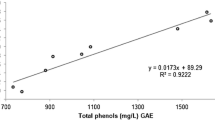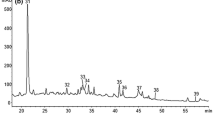Abstract
The phenolic compounds from white wine vinasses were concentrated following a patent pending process. From 1 L of wine vinasses up to 42 g of a dry product, containing 45% d.w. phenolics, could be obtained. The antioxidant activity of wine vinasse product was characterized for the reducing ability and for the scavenging capacity on non-biological radicals (DPPH· and ABTS·+), on the reactive oxygen species superoxide radical, peroxyl radical, H2O2, singlet oxygen, hypochlorous acid and on the reactive nitrogen species, nitric oxide, and peroxynitrite. The ability of the product to protect biological systems was preliminary evaluated through the protection against the β-carotene oxidation in emulsion and the lysis and lipid peroxidation induced by APPH in erythrocytes. The product showed activity comparable to that of standard compounds (ascorbic acid, butylhydroxyanisol, butylhydroxytoluene, lipoic acid, rutin, quercetin, Tiron, Trolox) and could be proposed as a food antioxidant. The absence of skin-irritant effects on reconstructed human tissues (Episkin™) showed that this product at 1% appear to be safe for topical use in cosmetic applications.




Similar content being viewed by others
References
Almeida, I. F., Fernandes, E., Lima, J. L., Valentão, P., Andrade, P. B., Seabra, R. M., et al. (2009). Oxygen and nitrogen reactive species are effectively scavenged by Eucalyptus globulus leaf water extract. Journal of Medicinal Food, 12, 175–183.
Arvanitoyannis, I. S., Ladas, D., & Mavromatis, A. (2006). Potential uses and applications of treated wine waste: A review. International Journal of Food Science & Technology, 41, 475–487.
Beltrán de Heredia, J., Dominguez, J. R., & Partido, E. (2005). Physico-chemical treatment for the depuration of wine distillery wastewaters (vinasses). Water Science and Technology, 51, 159–166.
Beltrán, F. J., García-Araya, J. F., & Álvarez, P. M. (1999). Wine distillery wastewater degradation. 2. Improvement of aerobic biodegradation by means of an integrated chemical (ozone)-biological treatment. Journal of Agricultural and Food Chemistry, 47, 3919–3924.
Benítez, F. J., Beltrán-Heredia, J., Real, F. J., & Acero, J. L. (2000). Wine vinasses treatments by ozone and an activated sludge system in continuous reactors. Bioprocess Engineering, 23, 149–154.
Benítez, F. J., Real, F. J., Acero, J. L., García, J., & Sánchez, M. (2003). Kinetics of the ozonation and aerobic biodegradation of wine vinasses in discontinuous and continuous processes. Journal of Hazardous Materials, 101, 203–218.
Borja, R., Martín, A., Maestro, R., Luque, M., & Durán, M. M. (1993). Enhancement of the anaerobic digestion of wine distillery wastewater by the removal of phenolic inhibitors. Bioresource Technology, 45, 99–104.
Faller, C., Bracher, M., Dami, N., & Roguet, R. (2002). Predictive ability of reconstructed human epidermis equivalents for the assessment of skin irritation of cosmetics. Toxicology in Vitro, 16, 557–572.
Gomes, A., Fernandes, E., Silva, A. M., Santos, C. M., Pinto, D. C., Cavaleiro, J. A., et al. (2007). 2-Styrylchromones: novel strong scavengers of reactive oxygen and nitrogen species. Bioorganic & Medicinal Chemistry, 15, 6027–6036.
Katalinić, V., Milos, M., Modun, D., Musić, I., & Boban, M. (2004). Antioxidant effectiveness of selected wines in comparison with (+)-catechin. Food Chemistry, 86, 593–600.
Lizárraga, D., Lozano, C., Briedé, J. J., Van Delft, J. H., Touriño, S., Centelles, J. J., et al. (2007). The importance of polymerization and galloylation for the antiproliferative properties of procyanidin-rich natural extracts. The FEBS Journal, 274, 4802–4811.
Miller, H. E. A. (1971). Simplified method for the evaluation of antioxidants. Journal of the American Oil Chemists' Society, 45, 91.
Moure, A., Domínguez, H., Parajó, J. C., González, M. J., Díaz Reinoso, B., Conde, E., Conde, M. J., González López, N., Levoso, A., Castro, M., Vidal, E., González, J. 2008 Procedimiento de recuperación de compuestos antioxidantes presentes en vinazas de alcoholera de vino. Pending Spanish Patent Application, ES200800076.
Pinelo, M., Rubilar, M., Sineiro, J., & Nuñez, M. J. (2005). A thermal treatment to increase the antioxidant capacity of natural phenols: Catechin, resveratrol and grape extract cases. European Food Research and Technology, 221, 284–290.
Pinelo, M., Ruiz-Rodríguez, A., Sineiro, J., Señoráns, F. J., Reglero, G., & Núñez, M. J. (2007). Supercritical fluid and solid–liquid extraction of phenolic antioxidants from grape pomace: A comparative study. European Food Research and Technology, 226, 199–205.
Portes, P., Grandidier, M. H., Cohen, C., & Roguet, R. (2002). Refinement of the Episkin protocol for the assessment of acute skin irritation of chemicals: follow-up to the ECVAM prevalidation study. Toxicol In Vitro, 16(6), 765–770.
Robinson, M. K., Cohen, C., de Brugerolle de Fraissinette, A., Ponec, M., Whittle, E., & Fentem, J. H. (2002). Non-animal testing strategies for assessment of the skin corrosion and skin irritation potential of ingredients and finished products. Food and Chemical Toxicology, 40, 573–592.
Spigno, G., & De Faveri, D. M. (2007). Antioxidants from grape stalks and marc: Influence of extraction procedure on yield, purity and antioxidant power of the extracts. Journal of Food Engineering, 78, 793–801.
Srour, M. A., Bilto, Y. Y., & Juma, M. (2000). Evaluation of different methods used to measure malonyldialdehyde in human erythrocytes. Clinical Hemorheology and Microcirculation, 23, 23–30.
Tornier, C., Amsellem, C., Fraissinette Ade, B., & Alépée, N. (2010). Assessment of the optimized SkinEthic reconstructed human epidermis (RHE) 42 bis skin irritation protocol over 39 test substances. Toxicology In Vitro, 24, 245–256.
Torres, J. L., & Selga, A. (2003). Procyanidin size and composition by thiolysis with cysteamine hydrochloride and chromatography. Chromatographia, 57, 441–445.
Torres, J. L., Varela, B., García, M. T., Carilla, J., Matito, C., Centelles, J. J., et al. (2002). Valorization of grape (Vitis vinifera) by-products. Antioxidant and biological properties of polyphenolic fractions differing in procyanidin composition and flavonol content. Journal of Agricultural and Food Chemistry, 50, 7548–7555.
Ugartondo, V., Mitjans, M., & Vinardell, M. P. (2008). Comparative antioxidant and cytotoxic effects of lignins from different sources. Bioresource Technology, 99, 6683–6687.
Ugartondo, V., Mitjans, M., Torres, J. L., & Vinardell, M. P. (2009). Biobased epicatechin conjugates protect erythrocytes and nontumoral cell lines from H2O2-induced oxidative stress. J Agricultural and Food Chemistry, 57, 4459–4465.
Whiteman, M., Ketsawatsakul, U., & Halliwell, B. (2002). A reassessment of the peroxynitrite scavenging activity of uric acid. Annals of the New York Academy of Sciences, 962, 242–259.
Xia, E. Q., Deng, G. F., Guo, Y. J., & Li, H. B. (2010). Biological activities of polyphenols from grapes. International Journal of Molecular Sciences, 11, 622–646.
Acknowledgments
The authors are grateful to the Spanish Ministry of Education and Science (MEC) for the financial support of this work (Research Project reference ALG2006-05387, CTM2009-12664, which had partial financial support from the FEDER funds of the European Union). Beatriz Díaz Reinoso thanks the Spanish MEC for her grant (reference BES-2005-7525). Andrés Moure thanks the Xunta de Galicia for his Isidro Parga Pondal contract. Daniele R. Nogueira thanks AECID for her grant.
Author information
Authors and Affiliations
Corresponding author
Rights and permissions
About this article
Cite this article
Díaz, B., Gomes, A., Freitas, M. et al. Valuable Polyphenolic Antioxidants from Wine Vinasses. Food Bioprocess Technol 5, 2708–2716 (2012). https://doi.org/10.1007/s11947-011-0569-8
Received:
Accepted:
Published:
Issue Date:
DOI: https://doi.org/10.1007/s11947-011-0569-8




